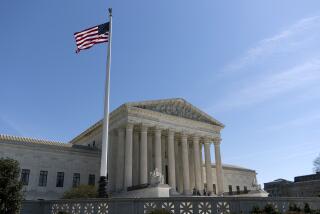EPA Finds Weighing Benefits, Costs Is a Double-Edged Sword
- Share via
WASHINGTON — As the chief regulator and enforcer of the nation’s environmental standards, the Environmental Protection Agency has silenced many opponents of its rulings with a powerful and sophisticated weapon known as the cost-benefit analysis.
The tool enables scientists and econometrists to tote up the risks to the population of a given social ill--an unregulated pollutant, for instance--and compare it to the costs--economic and social--of measures that would correct that ill.
Now, the agency’s critics have taken up the same weapon. And they are getting some help from members of Congress.
Last week, the Clinton Administration was forced to shelve, at least temporarily, a plan to elevate the EPA to Cabinet-level status when a majority of House lawmakers refused to vote on the question until the EPA agreed to conduct a cost-benefit analysis of each of its regulations and policies.
The decision--in which 60 Democrats broke ranks and sided with 167 Republicans in a key procedural vote--effectively derailed one of the Administration’s key environmental priorities and has put the White House on notice that all of its environmental initiatives could face similarly stiff opposition from a burgeoning coalition of critics.
Administration officials said that they already operate under an order to conduct cost-benefit assessments on any regulation with an economic impact of $100,000 or more.
But a requirement to do the analyses in all cases would paralyze the EPA with red tape and increase the costs of controlling pollution, they argued. The EPA’s number-crunchers estimated that the agency would have to spend $25 million to $30 million more a year and add 50 employees to carry out the policy as Congress envisioned it.
According to many lawmakers who back the idea, however, a cost-benefit analysis of new EPA regulations would show that lots of those directives exact tremendous economic tolls and deliver insignificant benefits to the public’s health and welfare. The result, they hope, would be fewer new federal environmental regulations and greater circumspection on the part of the government’s environmental agencies.
For most of the EPA’s 24-year history, the cost-benefit analysis has been one of the EPA’s most effective tools. Through the 1970s, analysts from the newly minted agency had little difficulty showing Congress that the benefits of controlling toxic pollutants greatly outweighed the costs of not doing so. Many U.S. rivers were so polluted they were catching fire, toxic chemical dumps littered the landscape and highly dangerous pesticides like DDT were in wide use in American communities.
But with more of the obvious problems now addressed, the EPA has turned increasingly to more subtle ones in which the science of risk assessment is inadequate and the trade-offs between the costs and benefits of a policy are less clear.
“So what’s happened is that people in industry and those inclined to want to deregulate have seized on these assessments as a way to trivialize or minimize the extent of a given problem,” said Adam Finkel, a fellow at the Center for Risk Management of Resources for the Future, an environmental think tank based in Washington that specializes in economic analysis.
In other cases, said Finkel, critics of a regulatory initiative use the analyses as a delaying tactic, since they frequently can be used to show that other environmental hazards should have higher regulatory priority.
But proponents of the cost-benefit proposal defend it as common sense.
“It will force us to set some priorities about issues, particularly since we have limited money and because many of these programs fall on local governments to implement and they don’t have the funds either,” said Rep. Gary A. Condit (D-Ceres). “I don’t think it stops us from having good environment law. It forces us to spend our money on the things that are highest risk. It’s a business application, a common-sense approach.”
More to Read
Get the L.A. Times Politics newsletter
Deeply reported insights into legislation, politics and policy from Sacramento, Washington and beyond. In your inbox three times per week.
You may occasionally receive promotional content from the Los Angeles Times.











